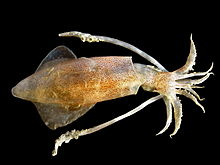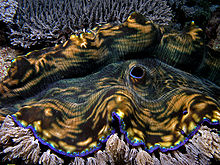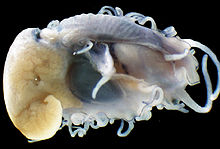- Mantle (mollusc)
-
 European Squid (Loligo vulgaris). The mantle is all that is visible behind the head: the outer body wall and the fins are all part of the mantle.
European Squid (Loligo vulgaris). The mantle is all that is visible behind the head: the outer body wall and the fins are all part of the mantle.
 The brightly coloured mantle of a Giant clam protects it from bright sunlight.
The brightly coloured mantle of a Giant clam protects it from bright sunlight.
The mantle (also known by the Latin word pallium meaning mantle, robe or cloak, adjective pallial) is a significant part of the anatomy of molluscs: it is the dorsal body wall which covers the visceral mass and usually protrudes in the form of flaps well beyond the visceral mass itself.
In many, but by no means all, species of molluscs, the epidermis of the mantle secretes calcium carbonate and conchiolin, and creates a shell.
The words mantle and pallium both originally meant cloak or cape, see mantle (vesture). This anatomical structure in molluscs often resembles a cloak because in many groups the edges of the mantle extend far beyond the main part of the body, forming flaps, double-layered structures which have been adapted for many different uses, including for example, the siphon.
Contents
The mantle cavity
The mantle cavity is a central feature of molluscan biology. This cavity is formed by the mantle skirt, a double fold of mantle which encloses a water space. This space contains the mollusc's gills, anus, osphradium, nephridiopores, and gonopores.
The mantle cavity functions as a respiratory chamber in most molluscs. In bivalves it is usually part of the feeding structure. In some molluscs the mantle cavity is a brood chamber, and in cephalopods and some bivalves such as scallops, it is a locomotory organ.
The mantle is highly muscular. In cephalopods the contraction of the mantle is used to force water through a tubular siphon, the hyponome, and this propels the animal very rapidly through the water. In gastropods it is used as a kind of "foot" for locomotion over the surface. In Patella the foot includes the entire ventral surface of the animal. The foot of the Bivalvia is a fleshy process adapted by its form to digging rather than to locomotion.
Formation of mollusc shell
Further information: mollusc shellIn shelled molluscs, the mantle is what forms the shell, and what adds to the shell to increase its size and strength as the animal grows. Shell material is secreted by the ectodermic (epithelial) cells of the mantle tissue.[1]
Mantle of gastropods
The mantle of many gastropods is usually fully or partially hidden inside the gastropod shell.
In species where the shell is small compared to the size of the body, more of the mantle shows. Shell-less slugs have the mantle fully visible. The dorsal surface of the mantle is called the notum, while the ventral surface of the mantle is called the hyponotum. In the family Philomycidae, the mantle covers the whole back side of the body.[2]
-
The mantle and the head of this slug Bielzia coerulans is smooth, while the rest of the body is tubercled.
-
Megapallifera mutabilis from Philomycidae shows enormously developed mantle
 This drawing shows that the mantle (in gray) covers the majority of the dorsal surface of the animal.[3]
This drawing shows that the mantle (in gray) covers the majority of the dorsal surface of the animal.[3]
See also
- Mollusc shell, which is formed by the mantle
- Siphon (mollusc) which is a part of the mantle in some groups of molluscs
References
- ^ "integument (molluscs)." Encyclopædia Britannica. 2009. Encyclopædia Britannica 2006 Ultimate Reference Suite DVD
- ^ Tsai C.-L. & Wu S.-K. (2008). "A New Meghimatium Slug (Pulmonata: Philomycidae) from Taiwan". Zoological Studies 47(6): 759-766. PDF.
- ^ Daniel J Jackson, Carmel McDougall, Kathryn Green, Fiona Simpson, Gert Wörheide & Bernard M Degnan. 2006. http://www.biomedcentral.com/1741-7007/4/40 A rapidly evolving secretome builds and patterns a sea shell]. BMC Biology 2006, 4:4. 0doi:10.1186/1741-7007-4-40.
Categories:- Mollusc anatomy
- Cephalopod zootomy
Wikimedia Foundation. 2010.






